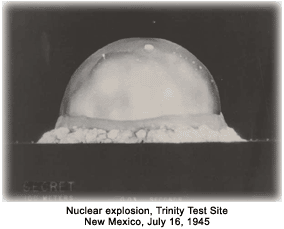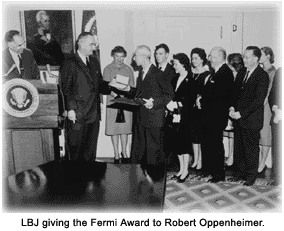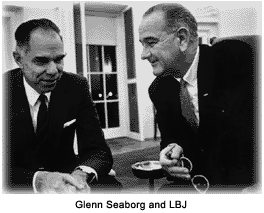The Atomic Energy Commission (AEC) was authorized by the Atomic Energy Act of 1946. It assumed the operations of The Manhattan Project on January 1, 1947, which began in 1942 to produce the first atomic bomb. Amendments to the act in 1954 gave the AEC new latitude with which to promote and regulate Nuclear Power. The conflict inherent in one agency performing both duties led to the dissolution of the AEC in 1974 and its replacement by two distinct agencies: the Nuclear Regulatory Agency and the Energy Research and Development Administration.
 In the period immediately following World War II, the method and degree to which the government would control nuclear materials and knowledge was widely debated. The Atomic Energy Act of 1946, also known as the McMahon Act, decided in favor of civilian control, but continued a strict government monopoly on both scientific and technological knowledge, and fissionable materials.
The first chairman of the AEC was David Lilienthal, the head of the Tennessee Valley Authority. Lilienthal`s experience with the TVA had given him insight into technical issues as well as experience with managing large projects. A general advisory committee was established to provide scientific advice to the commission. From 1947 to 1952, the committee was headed by J. Robert Oppenheimer, the chief scientist of the Manhattan Project. The commission’s most controversial advice was that the United States should continue to expand its atomic bomb arsenal rather than develop hydrogen bombs, which the committee deemed to be too destructive to have any purely military purpose. At the time, President Dwight D. Eisenhower was in favor of the development of the hydrogen bomb, since some other countries already possessed the technology to manufacture atomic bombs.
On that subject, their advice was ignored. Lilienthal resigned in protest in 1950 and was replaced by Gordon Dean, an original commissioner. When Eisenhower looked for a successor to Dean in 1953, he chose another original commissioner, Lewis Strauss, but Strauss would accept the position only on the condition that Oppenheimer be excluded from any influence within the AEC.
In the period immediately following World War II, the method and degree to which the government would control nuclear materials and knowledge was widely debated. The Atomic Energy Act of 1946, also known as the McMahon Act, decided in favor of civilian control, but continued a strict government monopoly on both scientific and technological knowledge, and fissionable materials.
The first chairman of the AEC was David Lilienthal, the head of the Tennessee Valley Authority. Lilienthal`s experience with the TVA had given him insight into technical issues as well as experience with managing large projects. A general advisory committee was established to provide scientific advice to the commission. From 1947 to 1952, the committee was headed by J. Robert Oppenheimer, the chief scientist of the Manhattan Project. The commission’s most controversial advice was that the United States should continue to expand its atomic bomb arsenal rather than develop hydrogen bombs, which the committee deemed to be too destructive to have any purely military purpose. At the time, President Dwight D. Eisenhower was in favor of the development of the hydrogen bomb, since some other countries already possessed the technology to manufacture atomic bombs.
On that subject, their advice was ignored. Lilienthal resigned in protest in 1950 and was replaced by Gordon Dean, an original commissioner. When Eisenhower looked for a successor to Dean in 1953, he chose another original commissioner, Lewis Strauss, but Strauss would accept the position only on the condition that Oppenheimer be excluded from any influence within the AEC.
 Expressing concerns about Oppenheimer`s loyalty and reliability due to his outspoken opinions during the Red Scare, the commission withdrew his security status in 1953. Oppenheimer appealed the decision and hearings were held in 1954 to determine whether his clearance should be restored. The commission decided against restoration. Oppenheimer continued to speak, write, and work in the field of physics and was later awarded the Enrico Fermi Award by President Lyndon B. Johnson, as a measure of reconciliation for what had occurred.
Euphoria over the prospects of Nuclear Power generation led to pressure from private industry to loosen the strict governmental monopoly. Amendments to the Atomic Energy Act in 1954 allowed private industry to own and operate nuclear power plants, to generate electricity for the public. The first two plants, one in Shippingport, Pennsylvania, and the other in Dresdon Station, New York, were built by Westinghouse and the Commonwealth Edison Company of Chicago, respectively.
The beginning success in the nuclear power industry led the United Nations to establish the International Atomic Energy Commission (IAEC) in 1957, to promote the safe use of nuclear power and to monitor the production and use of nuclear weapons around the world.
Strauss resigned from the AEC in 1958 when Eisenhower nominated him to be Secretary of Commerce. But Strauss` arrogant and condescending attitude towards Congress came back to haunt him when, after two months of hearings, he was rejected by the Senate. His replacement at the AEC was John McCone, who attempted to mend fences with Congress. His view was that the AEC was supposed to develop nuclear weapons of the greatest military value and that the test moratorium that Eisenhower had declared in 1958 was contrary to that mission.
Expressing concerns about Oppenheimer`s loyalty and reliability due to his outspoken opinions during the Red Scare, the commission withdrew his security status in 1953. Oppenheimer appealed the decision and hearings were held in 1954 to determine whether his clearance should be restored. The commission decided against restoration. Oppenheimer continued to speak, write, and work in the field of physics and was later awarded the Enrico Fermi Award by President Lyndon B. Johnson, as a measure of reconciliation for what had occurred.
Euphoria over the prospects of Nuclear Power generation led to pressure from private industry to loosen the strict governmental monopoly. Amendments to the Atomic Energy Act in 1954 allowed private industry to own and operate nuclear power plants, to generate electricity for the public. The first two plants, one in Shippingport, Pennsylvania, and the other in Dresdon Station, New York, were built by Westinghouse and the Commonwealth Edison Company of Chicago, respectively.
The beginning success in the nuclear power industry led the United Nations to establish the International Atomic Energy Commission (IAEC) in 1957, to promote the safe use of nuclear power and to monitor the production and use of nuclear weapons around the world.
Strauss resigned from the AEC in 1958 when Eisenhower nominated him to be Secretary of Commerce. But Strauss` arrogant and condescending attitude towards Congress came back to haunt him when, after two months of hearings, he was rejected by the Senate. His replacement at the AEC was John McCone, who attempted to mend fences with Congress. His view was that the AEC was supposed to develop nuclear weapons of the greatest military value and that the test moratorium that Eisenhower had declared in 1958 was contrary to that mission.
 Glenn Seaborg, who had worked on the Manhattan Project and shared the Nobel Prize in Chemistry in 1951, became the AEC`s next chairman in 1961. He served until 1971, longer than any other chairman. Under his administration, the AEC accelerated the commercialization of nuclear power, but concerns continued to grow about its dual role as promoter and regulator of the nuclear power industry.
Seaborg was succeeded by Dixie Lee Ray, who later became governor of Washington state. Criticism of the AEC`s priorities continued to mount, and finally in 1974, Congress abolished the AEC. Its regulatory duties were passed to the Nuclear Regulatory Agency, while its other tasks were given to the Energy Research and Development Administration, which was itself disbanded in 1977 when the Department of Energy was created.
Glenn Seaborg, who had worked on the Manhattan Project and shared the Nobel Prize in Chemistry in 1951, became the AEC`s next chairman in 1961. He served until 1971, longer than any other chairman. Under his administration, the AEC accelerated the commercialization of nuclear power, but concerns continued to grow about its dual role as promoter and regulator of the nuclear power industry.
Seaborg was succeeded by Dixie Lee Ray, who later became governor of Washington state. Criticism of the AEC`s priorities continued to mount, and finally in 1974, Congress abolished the AEC. Its regulatory duties were passed to the Nuclear Regulatory Agency, while its other tasks were given to the Energy Research and Development Administration, which was itself disbanded in 1977 when the Department of Energy was created.